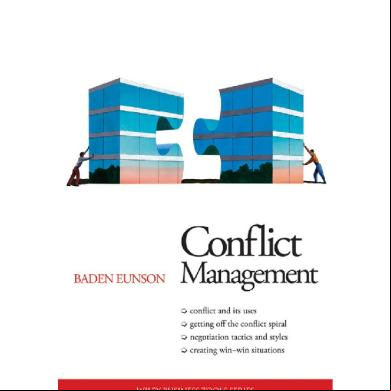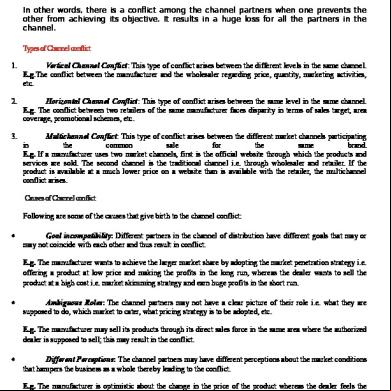Conflict Management 1q1o2n
This document was ed by and they confirmed that they have the permission to share it. If you are author or own the copyright of this book, please report to us by using this report form. Report 3b7i
Overview 3e4r5l
& View Conflict Management as PDF for free.
More details w3441
- Words: 1,418
- Pages: 33
What is conflict ?
11-2
Conflict Conflict: “A process in which one party perceives that its interests are being opposed or negatively affected by another
party.”
Functional conflict serves the organization’s interests while
dysfunctional conflict threatens the organization’s interests.
Different views of conflict 1.
Traditional view - assumes all conflict must be avoided
2.
Human relations view - assumes that all conflict are natural and inevitable outcome in any group
3.
Interactionist view - assumes that conflict is not only a positive force in a group but that it is absolutely necessary for a group to perform effectively.
11-4
Desired Outcomes of Conflict Agreement: Strive for equitable and fair agreements that last.
Stronger relationships: Build bridges of goodwill and trust for the future.
Learning: Greater self-awareness and creative problem solving.
Nepalese most: tend to go with the traditional view, often avoid conflict - partly cultural, assumes that the problem may go away if nothing is done about it Some American and European: tends to go with the interactionist view often encourage what may be called positive conflict
Such wide differing views create in its own conflicts: THE CLASHES OF CULTURES
Sources of conflict Ends (Goals, Task) Means (Process) Relationships
11-3a
Antecedents of Conflict • • • • • • •
Incompatible personalities or value systems. Overlapping or unclear job boundaries. Competition for limited resources. Interdepartment/intergroup competition. Inadequate communication. Interdependent tasks. Organizational complexity.
11-3b
Antecedents of Conflict (continued) • Unreasonable or unclear policies, standards, or rules. • Unreasonable deadlines or extreme time pressure. • Collective decision making. • Decision making by consensus. • Unmet expectations. • Unresolved or suppressed conflict.
The conflict within and your own response to conflict situations The more aware you are of your personal style, and the more ways you see of being able to resolve a particular conflict, the more sensitive, flexible, and successful you will be in coping with the problem.
Common Problems in Conflict Management
First, the parties will simply avoid the conflict. This can be damaging, because it can lead to greater problems in the future. It is usually best that the individuals discuss their differences. Second, individuals involved in conflict may blame the other individual. Often, individuals go beyond the specific behavior in question and blame the character of the person. Third adopting a win-lose mentality.
Tips for Managing Conflict Creative Response (Taking conflict as opportunity rather than problem, creatively responding to it by consciously choosing to see what can be done, rather than focusing on how terrible the situation is) Empathy ( Helping the other person understand that they are being heard and understood) Appropriate Assertiveness ( Being able to state your case without arousing the defenses of the other person, delivering a clean and clear statement of how it is from your side and how you would like it to be)
Tips for Managing Conflict Managing Emotions – Handling yourself ( Do not deny feelings but express it appropriately, avoid the desire to punish or blame, focus on improving the situation) – Handling Others (give attention to positive behaviour, their real contribution and involvement in the process, disengage from the struggle and help the other party use their power constructively by enlisting cooperation, their self worth and autonomy)
CUDSA model 1. Confront the conflict 2. Understand the other’s position 3. Define the problem(s) 4. Search for and evaluate Alternative solutions 5. Agree upon, implement and evaluate the Best solution
Tips for Employees Having a Personality Conflict Follow company policies for diversity, anti-discrimination, and sexual harassment. Communicate directly with the other person to resolve the perceived conflict (focus on the tips presented above). Avoid dragging co-workers into the conflict. If dysfunctional conflict persists, seek help from direct supervisors or human resource specialists.
Tips for Third-Party Observers of a Personality Conflict Follow company policies for diversity, anti-discrimination, and sexual harassment. Do not take sides in someone else’s personality conflict. Suggest the parties work things out themselves in a constructive and positive way. If dysfunctional conflict persists, refer the problem to parties’ direct supervisors.
Tips for Managers Whose Employees Are Having Personality Conflict Follow company policies for diversity, antidiscrimination, and sexual harassment. Investigate and document conflict. If necessary, attempt informal dispute resolution. If appropriate, take corrective action (e.g., , mediation). Refer difficult conflicts to human resource specialists or hired counselors for formal resolution attempts and other interventions.
The Conflict Iceberg Issues Personalities Emotions Interests, needs, desires Self-perceptions and self-esteem Hidden Expectations Unresolved Issues from the past
Awareness of Interconnection
The Conflict Process Stage I Potential Opposition Antecedent Conditions: • Structure • Communication • Personal Variables
Perceived Conflict
Felt Conflict
Stage II Cognition and Personalization
Stage III Intentions Conflict-Handling Intentions: • Competition • Collaboration • Accommodation • Avoidance • Compromise
Overt Conflict: • Party’s Behavior • Other’s Reaction Stage IV Behavior
Stage V Outcomes Increased Group Performance (Functional Conflict)
Decreased Group Performance (Dysfunctional Conflict)
Cognition and Personalization Stage II Phases Perceived Conflict
Felt Conflict
Assertive
Competing
Collaborating
(Forcing)
Compromising Unassertive
Assertiveness
Conflict-Handling Styles
Avoiding
Accommodating Cooperative
Uncooperative
Cooperativeness
11-10
Alternative Dispute Resolution (ADR) Techniques Facilitation: Third party gets disputants to deal directly and constructively with each other.
Conciliation: Neutral third party acts as communication link between disputants.
Peer review: Impartial co-workers hear both sides and render decision that may or may not be binding.
Ombudsman: Respected and trusted member of the organization hears grievances confidentially.
Mediation: Trained third-party guides disputants toward their own solution.
Arbitration: Neutral third-party hears both sides in a court-like setting and renders a binding decision.
Practical Application: Conflict-Handling Styles What contingency variables influence the appropriateness of different conflict handling styles? For each conflict handling style, describe a situation where that style would be the most appropriate
Interpersonal Conflict Handling Styles Avoiding Style – Unassertive and uncooperative
Forcing Style – Assertive and uncooperative
Accommodating Style – Unassertive and cooperative
Collaborating Style – Assertive and cooperative
Compromising Style – Intermediate level of assertive and cooperative behaviors
When Should the Avoiding Style Be Used to Handle Interpersonal Conflicts?
The issue is of minor or ing importance. Insufficient information to effectively deal with the
conflict. Low power relative to the other party.
Others can more effectively resolve the conflict.
When Should the Forcing Style Be Used to Handle Interpersonal Conflicts?
Emergencies requiring quick action. Unpopular actions must be taken for long-term organizational effectiveness and survival. Self-protective action needed.
When Should the Accommodating Style Be Used to Handle Interpersonal Conflicts?
Need to defuse a potentially explosive emotional conflict situation. Short-run need to keep harmony and avoid disruption. Conflict is primarily personality based and cannot be easily resolved.
When Should the Collaborating Style Be Used to Handle Interpersonal Conflicts?
Sufficient required interdependence of conflicting parties. Sufficient parity in power of conflicting parties. Potential for long-run mutual benefits. Sufficient organizational to take the time and energy for collaboration.
When Should the Compromising Style Be Used to Handle Interpersonal Conflicts?
Agreement enables each party to be better off, or at least not worse off, than without an agreement. Achieving a total win-win agreement is not possible. Conflicting goals block agreement on one person’s proposal.
The Johari Window Known to self
Known to others
Not known to others
Not Known to self
I Open Area
II Blind Area ()
III Hidden Area (Disclose)
IV Unknown Area (Experiment/Test)
Quadrant I: The open area, refers to behaviour and motivation known to self and others Quadrant II: The blind area represents things that others can see in us that we ourselves are unaware of Quadrant III: The hidden area represents things we know about ourselves but do not reveal to others Quadrant IV: The unknown area in which neither the individual nor others are aware of certain behaviours or motives
11-11
Negotiating Negotiation: “A give-and-take decision-making process involving interdependent parties with different preferences.”
Distributive negotiation: Single issue; fixed-pie; win-lose.
Integrative negotiation: More than one issue; win-win.
Two Negotiating (Bargaining) Strategies Bargaining Characteristics
Distributive Bargaining
Integrative Bargaining
• Available Resources
• Fixed Amount
• Variable Amount
• Primary Motivations
• I Win, You Lose
• I Win, You Win
• Primary Interests
• Opposed
• Congruent
• Focus of Relationships
• Short-Term
• Long-Term
The Bargaining Zone Party A’s Aspiration Range
Party A’s Target Point
Settlement
Party B’s Resistance Point
Range
Party B’s Aspiration Range
Party A’s Resistance Point
Party B’s Target Point
The Process of Negotiation Preparation and Planning (BATNA)
Clarification and Justification
Closure and Implementation
Definition of Ground Rules
Bargaining and Problem Solving
11-2
Conflict Conflict: “A process in which one party perceives that its interests are being opposed or negatively affected by another
party.”
Functional conflict serves the organization’s interests while
dysfunctional conflict threatens the organization’s interests.
Different views of conflict 1.
Traditional view - assumes all conflict must be avoided
2.
Human relations view - assumes that all conflict are natural and inevitable outcome in any group
3.
Interactionist view - assumes that conflict is not only a positive force in a group but that it is absolutely necessary for a group to perform effectively.
11-4
Desired Outcomes of Conflict Agreement: Strive for equitable and fair agreements that last.
Stronger relationships: Build bridges of goodwill and trust for the future.
Learning: Greater self-awareness and creative problem solving.
Nepalese most: tend to go with the traditional view, often avoid conflict - partly cultural, assumes that the problem may go away if nothing is done about it Some American and European: tends to go with the interactionist view often encourage what may be called positive conflict
Such wide differing views create in its own conflicts: THE CLASHES OF CULTURES
Sources of conflict Ends (Goals, Task) Means (Process) Relationships
11-3a
Antecedents of Conflict • • • • • • •
Incompatible personalities or value systems. Overlapping or unclear job boundaries. Competition for limited resources. Interdepartment/intergroup competition. Inadequate communication. Interdependent tasks. Organizational complexity.
11-3b
Antecedents of Conflict (continued) • Unreasonable or unclear policies, standards, or rules. • Unreasonable deadlines or extreme time pressure. • Collective decision making. • Decision making by consensus. • Unmet expectations. • Unresolved or suppressed conflict.
The conflict within and your own response to conflict situations The more aware you are of your personal style, and the more ways you see of being able to resolve a particular conflict, the more sensitive, flexible, and successful you will be in coping with the problem.
Common Problems in Conflict Management
First, the parties will simply avoid the conflict. This can be damaging, because it can lead to greater problems in the future. It is usually best that the individuals discuss their differences. Second, individuals involved in conflict may blame the other individual. Often, individuals go beyond the specific behavior in question and blame the character of the person. Third adopting a win-lose mentality.
Tips for Managing Conflict Creative Response (Taking conflict as opportunity rather than problem, creatively responding to it by consciously choosing to see what can be done, rather than focusing on how terrible the situation is) Empathy ( Helping the other person understand that they are being heard and understood) Appropriate Assertiveness ( Being able to state your case without arousing the defenses of the other person, delivering a clean and clear statement of how it is from your side and how you would like it to be)
Tips for Managing Conflict Managing Emotions – Handling yourself ( Do not deny feelings but express it appropriately, avoid the desire to punish or blame, focus on improving the situation) – Handling Others (give attention to positive behaviour, their real contribution and involvement in the process, disengage from the struggle and help the other party use their power constructively by enlisting cooperation, their self worth and autonomy)
CUDSA model 1. Confront the conflict 2. Understand the other’s position 3. Define the problem(s) 4. Search for and evaluate Alternative solutions 5. Agree upon, implement and evaluate the Best solution
Tips for Employees Having a Personality Conflict Follow company policies for diversity, anti-discrimination, and sexual harassment. Communicate directly with the other person to resolve the perceived conflict (focus on the tips presented above). Avoid dragging co-workers into the conflict. If dysfunctional conflict persists, seek help from direct supervisors or human resource specialists.
Tips for Third-Party Observers of a Personality Conflict Follow company policies for diversity, anti-discrimination, and sexual harassment. Do not take sides in someone else’s personality conflict. Suggest the parties work things out themselves in a constructive and positive way. If dysfunctional conflict persists, refer the problem to parties’ direct supervisors.
Tips for Managers Whose Employees Are Having Personality Conflict Follow company policies for diversity, antidiscrimination, and sexual harassment. Investigate and document conflict. If necessary, attempt informal dispute resolution. If appropriate, take corrective action (e.g., , mediation). Refer difficult conflicts to human resource specialists or hired counselors for formal resolution attempts and other interventions.
The Conflict Iceberg Issues Personalities Emotions Interests, needs, desires Self-perceptions and self-esteem Hidden Expectations Unresolved Issues from the past
Awareness of Interconnection
The Conflict Process Stage I Potential Opposition Antecedent Conditions: • Structure • Communication • Personal Variables
Perceived Conflict
Felt Conflict
Stage II Cognition and Personalization
Stage III Intentions Conflict-Handling Intentions: • Competition • Collaboration • Accommodation • Avoidance • Compromise
Overt Conflict: • Party’s Behavior • Other’s Reaction Stage IV Behavior
Stage V Outcomes Increased Group Performance (Functional Conflict)
Decreased Group Performance (Dysfunctional Conflict)
Cognition and Personalization Stage II Phases Perceived Conflict
Felt Conflict
Assertive
Competing
Collaborating
(Forcing)
Compromising Unassertive
Assertiveness
Conflict-Handling Styles
Avoiding
Accommodating Cooperative
Uncooperative
Cooperativeness
11-10
Alternative Dispute Resolution (ADR) Techniques Facilitation: Third party gets disputants to deal directly and constructively with each other.
Conciliation: Neutral third party acts as communication link between disputants.
Peer review: Impartial co-workers hear both sides and render decision that may or may not be binding.
Ombudsman: Respected and trusted member of the organization hears grievances confidentially.
Mediation: Trained third-party guides disputants toward their own solution.
Arbitration: Neutral third-party hears both sides in a court-like setting and renders a binding decision.
Practical Application: Conflict-Handling Styles What contingency variables influence the appropriateness of different conflict handling styles? For each conflict handling style, describe a situation where that style would be the most appropriate
Interpersonal Conflict Handling Styles Avoiding Style – Unassertive and uncooperative
Forcing Style – Assertive and uncooperative
Accommodating Style – Unassertive and cooperative
Collaborating Style – Assertive and cooperative
Compromising Style – Intermediate level of assertive and cooperative behaviors
When Should the Avoiding Style Be Used to Handle Interpersonal Conflicts?
The issue is of minor or ing importance. Insufficient information to effectively deal with the
conflict. Low power relative to the other party.
Others can more effectively resolve the conflict.
When Should the Forcing Style Be Used to Handle Interpersonal Conflicts?
Emergencies requiring quick action. Unpopular actions must be taken for long-term organizational effectiveness and survival. Self-protective action needed.
When Should the Accommodating Style Be Used to Handle Interpersonal Conflicts?
Need to defuse a potentially explosive emotional conflict situation. Short-run need to keep harmony and avoid disruption. Conflict is primarily personality based and cannot be easily resolved.
When Should the Collaborating Style Be Used to Handle Interpersonal Conflicts?
Sufficient required interdependence of conflicting parties. Sufficient parity in power of conflicting parties. Potential for long-run mutual benefits. Sufficient organizational to take the time and energy for collaboration.
When Should the Compromising Style Be Used to Handle Interpersonal Conflicts?
Agreement enables each party to be better off, or at least not worse off, than without an agreement. Achieving a total win-win agreement is not possible. Conflicting goals block agreement on one person’s proposal.
The Johari Window Known to self
Known to others
Not known to others
Not Known to self
I Open Area
II Blind Area ()
III Hidden Area (Disclose)
IV Unknown Area (Experiment/Test)
Quadrant I: The open area, refers to behaviour and motivation known to self and others Quadrant II: The blind area represents things that others can see in us that we ourselves are unaware of Quadrant III: The hidden area represents things we know about ourselves but do not reveal to others Quadrant IV: The unknown area in which neither the individual nor others are aware of certain behaviours or motives
11-11
Negotiating Negotiation: “A give-and-take decision-making process involving interdependent parties with different preferences.”
Distributive negotiation: Single issue; fixed-pie; win-lose.
Integrative negotiation: More than one issue; win-win.
Two Negotiating (Bargaining) Strategies Bargaining Characteristics
Distributive Bargaining
Integrative Bargaining
• Available Resources
• Fixed Amount
• Variable Amount
• Primary Motivations
• I Win, You Lose
• I Win, You Win
• Primary Interests
• Opposed
• Congruent
• Focus of Relationships
• Short-Term
• Long-Term
The Bargaining Zone Party A’s Aspiration Range
Party A’s Target Point
Settlement
Party B’s Resistance Point
Range
Party B’s Aspiration Range
Party A’s Resistance Point
Party B’s Target Point
The Process of Negotiation Preparation and Planning (BATNA)
Clarification and Justification
Closure and Implementation
Definition of Ground Rules
Bargaining and Problem Solving










